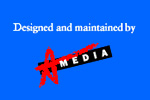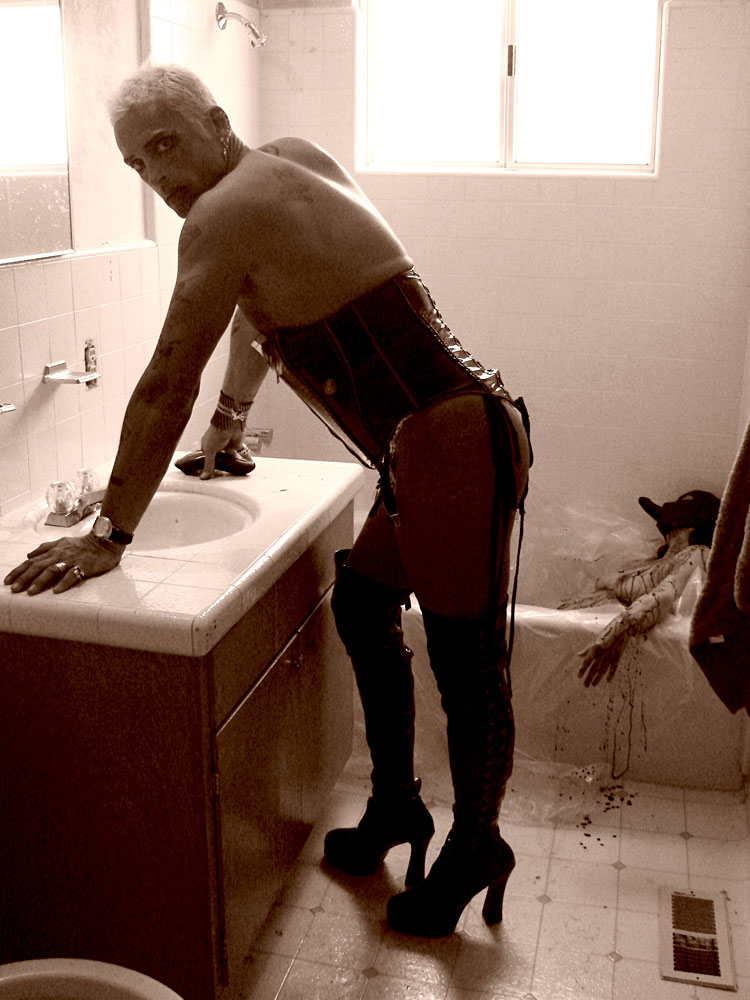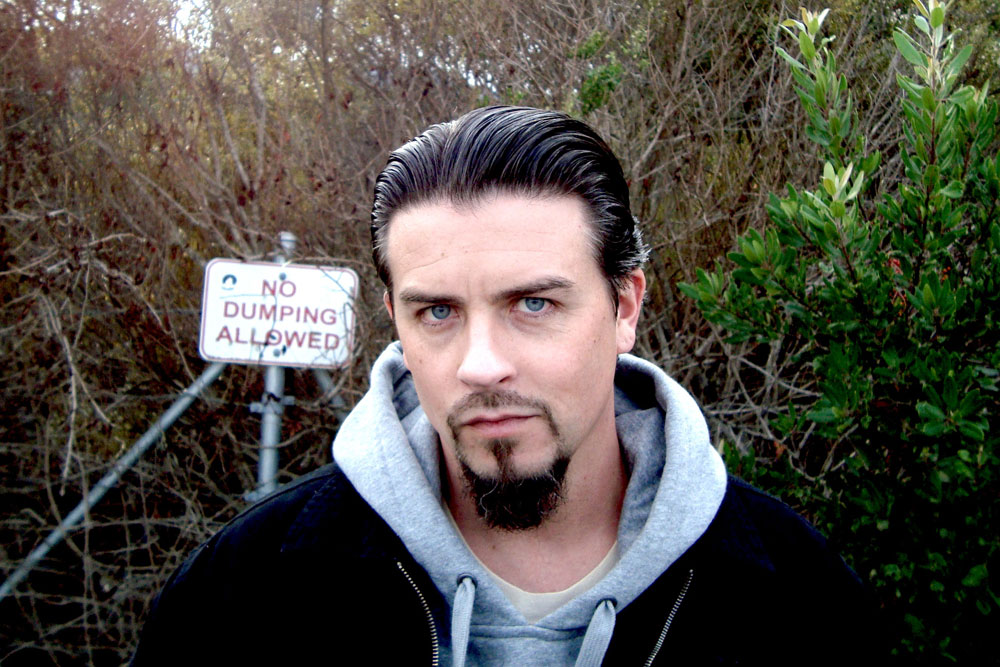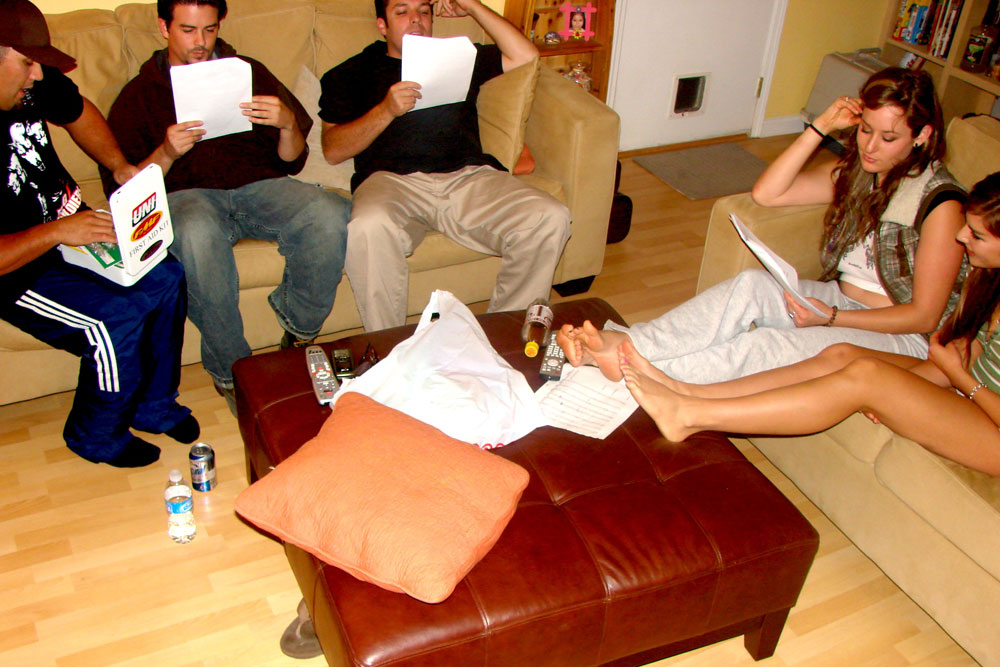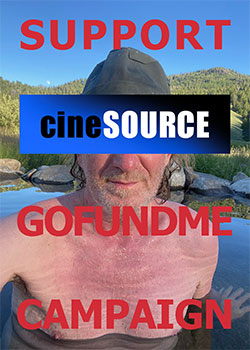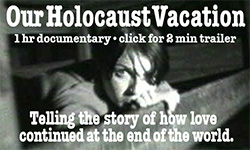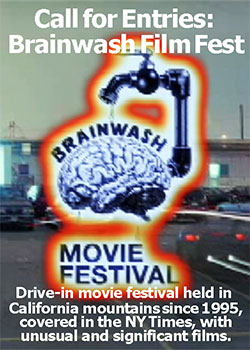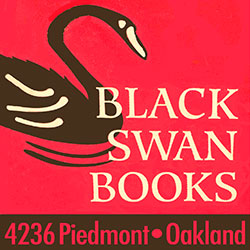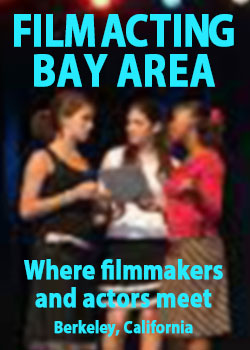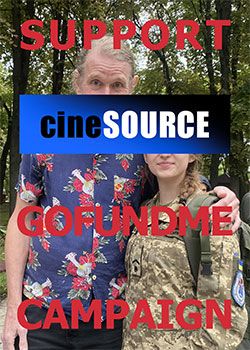Blue Collar Horror
by Luca Vastardis with Nelson Carnicelli
In the heyday of exploitation and horror cinema, the 1960s through ‘80s, young and relatively inexperienced filmmakers were creating some of the genre’s most shockingly violent, thought-provoking and enduring cult classics.
“Those were some seriously nasty and mean-spirited films, but there was always something more going on beneath the surface,” proclaims first-time filmmaker Dave O’Shea, whose indie horror-suspence feature “Day Job” just won the Best Local Feature Award at SF IndieFest’s Another Hole in the Head Film Festival. “There was something magical going on back then."
With minuscule budgets, often using borrowed equipment and friends as actors and crew, these mavericks did whatever it took to make the movies they wanted to make. And there was a good chance their films would end up on the big screen at a grindhouse theater or local drive-in, bringing audiences innovative thrills and chills on a regular basis.
Then, sometime in mid-‘80s, things changed. Reagan-era Puritanism, with help from the heavy hand of the Motion Picture Association of America, which does the ratings, began squeezing the life out of subversive shock-cinema. Drive-ins and grindhouses were forced out of business and by the mid-‘90s these sort of high-concept/low-budget films were all but ancient history.
After witnessing this painful decline, O’Shea, a Bay Area native and lifelong artist, decided to stop complaining and do something about it.
“I was the guy constantly bitching about how watered-down everything had become. Each new horror film was glossier and more dishonest than the last. So, at some point I thought, fuck it, I’ll write a movie my damn self. And if I can’t find anyone to put up some money, I’ll just figure out a way.”
Throwing caution to the wind, O'Shea, a thirteen-year cable industry veteran, or Cable Guy, would eventually write “Day Job,” based on those experiences, and then produce, direct, star in and edit the movie over the next six years. The budget was barely more than “gas money and gratitude” as well as the immense assistance of a crew of equally inexperienced but enthusiastic friends and acquaintances.
His demented labor of love tells the story of a disturbed Cable Guy who becomes obsessed with a beautiful but neglected young housewife he meets on the job. While a little rough around the edges in the camera and concise editing department, this genuinely creepy shocker also took home the Best Exploitation Film and Best Use of Violence/Gore awards at its debut at the Pollygrind Underground Film Festival in Las Vegas.
Backing up a bit, the story of what inspired “Day Job” is highlights the commonplaceness that can make horror work.
“It’s a weird job, [being a Cable Guy]. You’re interacting with people on this strange, superficial level inside their homes. It’s completely unnatural, but great inspiration for a writer. Some of the stuff I’ve seen over the years, you couldn’t make up.”
On one particular occasion in 2004, O’Shea arrived a little late a customer’s house. The man had received a courtesy call explaining the delay—a minor inconvenience usually handled graciously. Not this time!
O’Shea had barely stepped out of his truck before the furious man was on his front porch, barking passive-aggressive insults into his bluetooth headset while pointing at his watch in a condescending fashion.
“That guy was a real piece of shit," O’Shea recalls. "At first I didn’t see his earpiece and thought he was just yelling at me, but then I realized he was yelling ABOUT me.”
“As I’m walking towards the house, ready to fix this clown’s cable, and he continues insulting me over his bluetooth: ‘These assholes are always late,’ ‘look at this young little punk they sent to my house,’ stuff like that. And I’m three feet away!” That’s when the wheels started turning.
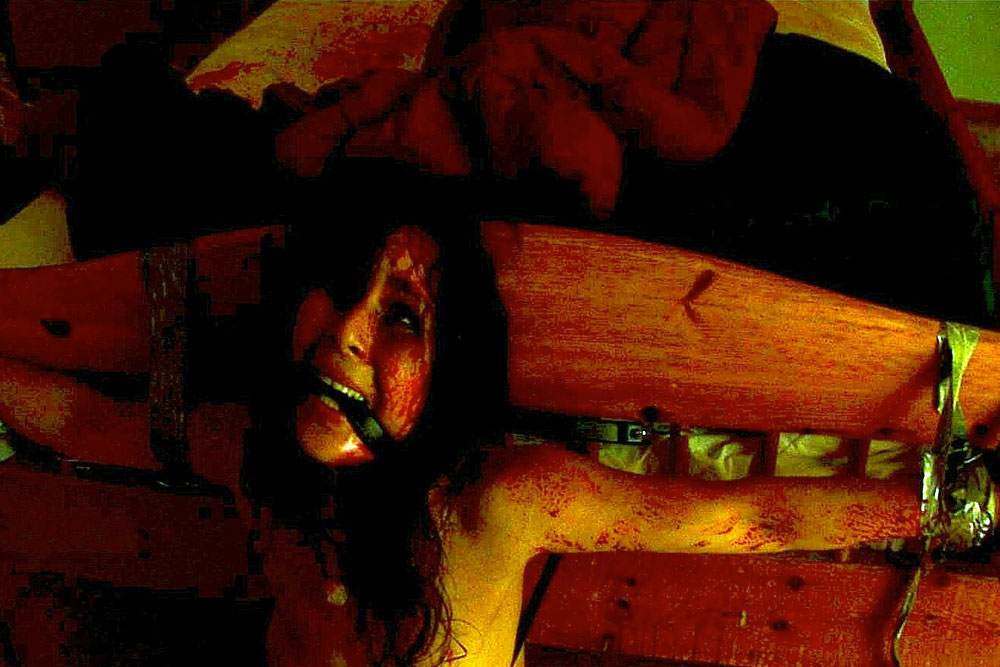 Gore-galore is a horror standard and in this 'Day Job' excelled, even winning the Pollygrind Festival's Gore Award. photo: courtesy Blatant Rip Off“It’s funny, it all came to me in a matter of, like, five seconds. This guy knows absolutely nothing about me, why I’m late or how I might react to his little hissy-fit. But I know who he is, where he lives. In a minute, I’ll know the entire layout of his home, including access to crawlspaces and whatever else."
Gore-galore is a horror standard and in this 'Day Job' excelled, even winning the Pollygrind Festival's Gore Award. photo: courtesy Blatant Rip Off“It’s funny, it all came to me in a matter of, like, five seconds. This guy knows absolutely nothing about me, why I’m late or how I might react to his little hissy-fit. But I know who he is, where he lives. In a minute, I’ll know the entire layout of his home, including access to crawlspaces and whatever else."
"And guess what? My fingerprints are supposed to be all over everything. For all he knows, I could be a serial killer.” O’Shea shakes his head in disgust.
“By the end of the job, he was all apologies and offering me a drink, you know the type. But I’m glad he was such a prick, he really inspired me to take my frustrations out on paper.” And then film.
Realizing this was something he’d never seen in a movie, O’Shea ran with the ‘cable guy serial killer’ concept and began writing furiously. He mixed in real life scenarios and characters like the angry customer, the perverted coworker, the religious freak, the lonely housewife, all the types he encountered day after day.
"Somewhat effortlessly," he says, “'Day Job' took shape. I was having dinner with some friends who had a downstairs loft that was being used for storage. I told them about my story and asked if I could use that room to shoot in. They weren’t too keen on the idea but mentioned a vacant house they owned.”
After taking a tour, he knew immediately it would make the ideal ‘murder house’ for his main characters, the evil Cable Guy, Nick (O'Shea), and Nick's unhinged, cross-dressing roommate, a part his good friend Tad Matthew Morgan, a veteran theater performer, eventually agreed to take on.
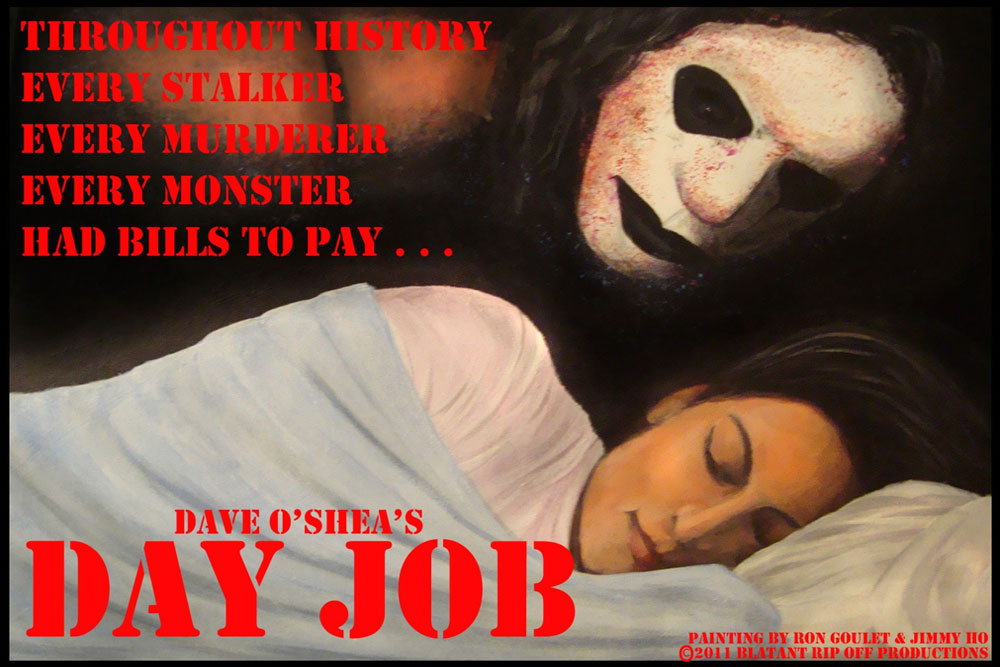 'Day Job''s poster, highlighting the normative existence trope that brings horror genre home—indeed, into the home. photo: courtesy Blatant Rip Off“The outside looked fine, but the interior was gutted, carpets were all ripped out. It looked like an abandoned shack you’d find squatters in. They said I could use it for six months or so before they started renovating, so I just got my shit together and a month later we were shooting.” For more on O'Shea's film and art work, see his site: Blatant Rip Off.
'Day Job''s poster, highlighting the normative existence trope that brings horror genre home—indeed, into the home. photo: courtesy Blatant Rip Off“The outside looked fine, but the interior was gutted, carpets were all ripped out. It looked like an abandoned shack you’d find squatters in. They said I could use it for six months or so before they started renovating, so I just got my shit together and a month later we were shooting.” For more on O'Shea's film and art work, see his site: Blatant Rip Off.
“I had no money and was nowhere near ready to shoot, mind you, but there was no time to think rationally about it. That house was too good to pass up.”
This was in October of 2006. Once time ran out at the "murder house," the rest of “Day Job” was shot scene by scene, guerrilla style at countless locations all across the greater Bay Area during the next four and a half years. Indeed, he gets some very realistic bar scenes, male-female interaction and story set-up in the process.
“I would definitely not recommend anyone trying to do it the way I did,” he reflects. “It worked out since I’m the type who learns by doing everything the hard way. It was sort of a nightmare but diving in headfirst we did.”
“The directing part came pretty naturally and I’ve got a decent eye for visuals. The other behind-the-scenes stuff wasn’t so fun, like coordinating everyone’s schedules, babysitting flaky cast members, stroking egos and whatever else. It was a lot of fun when things came together—don’t get me wrong—but it got frustrating at times. I’m amazed I still have any friends left.”
After the long and difficult journey creating the film, the thirty-six year old filmmaker is quite fond of what he and his motley crew were able to accomplish.
“It turned out way better than it had any right to. Even though none of us really knew what we were doing, especially in the beginning, we took it seriously and I think it shows. Everyone pitched in as much as they could and it all worked out.”
As for the gritty appearance of the film? “For all its technical imperfections, it’s still a pretty cool little horror movie. I’m probably in the minority here, but I like the unpolished look of it, it adds a certain sleazy charm. It was never meant to be pretty.”
Which brings us to today, the film has been completed for a number of months, has received some quite favorable reviews—the LA Horror reviewer hailed “Day Job” as “one of the nastiest, most intelligent and original indie horror films I’ve ever seen”), and already has two awards under its belt, thanks to Pollygrind.
“Pollygrind was a amazing. Festival director Chad Freeman really goes out of his way to help get us unknowns some recognition. Something I didn’t anticipate was how much of a scam a lot of film festivals are nowadays, even some of the smaller ones. They’re all about which celebrities they can get on their red carpets."
"It’s got nothing to do with discovering new talent like it was, maybe fifteen years ago, when guys like Tarantino and Kevin Smith were coming up. It’s nice to see people like Chad are still out there, rooting for the underdogs.”
“I cannot wait for Another Hole in the Head," at the Roxie Theatre. "It’s such a highly regarded festival, known for breaking a lot of interesting newcomers. Thankfully, they don’t shy away from the really dark stuff. I could not be more proud to have been invited. It’s a big deal.”
Which takes us back to reminiscing about the golden age of high-concept/low budget horror and exploitation films of thirty or forty years ago. At the time, the biggest obstacle for indie filmmakers was getting their hands on money to buy and process film and gaining access to editing equipment. Nowadays, you can write a script, get an affordable digital camera and a computer, grab some friends and make any kind of movie you want. Anyone can do it, even a Cable Guy!
“Look, if you have a story to tell, there are no excuses anymore. Just get off your ass and do it.”
Posted on Dec 12, 2012 - 09:14 AM
by Luca Vastardis with Nelson Carnicelli
In the heyday of exploitation and horror cinema, the 1960s through ‘80s, young and relatively inexperienced filmmakers were creating some of the genre’s most shockingly violent, thought-provoking and enduring cult classics.
“Those were some seriously nasty and mean-spirited films, but there was always something more going on beneath the surface,” proclaims first-time filmmaker Dave O’Shea, whose indie horror-suspence feature “Day Job” just won the Best Local Feature Award at SF IndieFest’s Another Hole in the Head Film Festival. “There was something magical going on back then."
With minuscule budgets, often using borrowed equipment and friends as actors and crew, these mavericks did whatever it took to make the movies they wanted to make. And there was a good chance their films would end up on the big screen at a grindhouse theater or local drive-in, bringing audiences innovative thrills and chills on a regular basis.
Then, sometime in mid-‘80s, things changed. Reagan-era Puritanism, with help from the heavy hand of the Motion Picture Association of America, which does the ratings, began squeezing the life out of subversive shock-cinema. Drive-ins and grindhouses were forced out of business and by the mid-‘90s these sort of high-concept/low-budget films were all but ancient history.
After witnessing this painful decline, O’Shea, a Bay Area native and lifelong artist, decided to stop complaining and do something about it.
“I was the guy constantly bitching about how watered-down everything had become. Each new horror film was glossier and more dishonest than the last. So, at some point I thought, fuck it, I’ll write a movie my damn self. And if I can’t find anyone to put up some money, I’ll just figure out a way.”
Throwing caution to the wind, O'Shea, a thirteen-year cable industry veteran, or Cable Guy, would eventually write “Day Job,” based on those experiences, and then produce, direct, star in and edit the movie over the next six years. The budget was barely more than “gas money and gratitude” as well as the immense assistance of a crew of equally inexperienced but enthusiastic friends and acquaintances.
His demented labor of love tells the story of a disturbed Cable Guy who becomes obsessed with a beautiful but neglected young housewife he meets on the job. While a little rough around the edges in the camera and concise editing department, this genuinely creepy shocker also took home the Best Exploitation Film and Best Use of Violence/Gore awards at its debut at the Pollygrind Underground Film Festival in Las Vegas.
Backing up a bit, the story of what inspired “Day Job” is highlights the commonplaceness that can make horror work.
“It’s a weird job, [being a Cable Guy]. You’re interacting with people on this strange, superficial level inside their homes. It’s completely unnatural, but great inspiration for a writer. Some of the stuff I’ve seen over the years, you couldn’t make up.”
On one particular occasion in 2004, O’Shea arrived a little late a customer’s house. The man had received a courtesy call explaining the delay—a minor inconvenience usually handled graciously. Not this time!
O’Shea had barely stepped out of his truck before the furious man was on his front porch, barking passive-aggressive insults into his bluetooth headset while pointing at his watch in a condescending fashion.
“That guy was a real piece of shit," O’Shea recalls. "At first I didn’t see his earpiece and thought he was just yelling at me, but then I realized he was yelling ABOUT me.”
“As I’m walking towards the house, ready to fix this clown’s cable, and he continues insulting me over his bluetooth: ‘These assholes are always late,’ ‘look at this young little punk they sent to my house,’ stuff like that. And I’m three feet away!” That’s when the wheels started turning.
 Gore-galore is a horror standard and in this 'Day Job' excelled, even winning the Pollygrind Festival's Gore Award. photo: courtesy Blatant Rip Off
Gore-galore is a horror standard and in this 'Day Job' excelled, even winning the Pollygrind Festival's Gore Award. photo: courtesy Blatant Rip Off"And guess what? My fingerprints are supposed to be all over everything. For all he knows, I could be a serial killer.” O’Shea shakes his head in disgust.
“By the end of the job, he was all apologies and offering me a drink, you know the type. But I’m glad he was such a prick, he really inspired me to take my frustrations out on paper.” And then film.
Realizing this was something he’d never seen in a movie, O’Shea ran with the ‘cable guy serial killer’ concept and began writing furiously. He mixed in real life scenarios and characters like the angry customer, the perverted coworker, the religious freak, the lonely housewife, all the types he encountered day after day.
"Somewhat effortlessly," he says, “'Day Job' took shape. I was having dinner with some friends who had a downstairs loft that was being used for storage. I told them about my story and asked if I could use that room to shoot in. They weren’t too keen on the idea but mentioned a vacant house they owned.”
After taking a tour, he knew immediately it would make the ideal ‘murder house’ for his main characters, the evil Cable Guy, Nick (O'Shea), and Nick's unhinged, cross-dressing roommate, a part his good friend Tad Matthew Morgan, a veteran theater performer, eventually agreed to take on.
 'Day Job''s poster, highlighting the normative existence trope that brings horror genre home—indeed, into the home. photo: courtesy Blatant Rip Off
'Day Job''s poster, highlighting the normative existence trope that brings horror genre home—indeed, into the home. photo: courtesy Blatant Rip Off“I had no money and was nowhere near ready to shoot, mind you, but there was no time to think rationally about it. That house was too good to pass up.”
This was in October of 2006. Once time ran out at the "murder house," the rest of “Day Job” was shot scene by scene, guerrilla style at countless locations all across the greater Bay Area during the next four and a half years. Indeed, he gets some very realistic bar scenes, male-female interaction and story set-up in the process.
“I would definitely not recommend anyone trying to do it the way I did,” he reflects. “It worked out since I’m the type who learns by doing everything the hard way. It was sort of a nightmare but diving in headfirst we did.”
“The directing part came pretty naturally and I’ve got a decent eye for visuals. The other behind-the-scenes stuff wasn’t so fun, like coordinating everyone’s schedules, babysitting flaky cast members, stroking egos and whatever else. It was a lot of fun when things came together—don’t get me wrong—but it got frustrating at times. I’m amazed I still have any friends left.”
After the long and difficult journey creating the film, the thirty-six year old filmmaker is quite fond of what he and his motley crew were able to accomplish.
“It turned out way better than it had any right to. Even though none of us really knew what we were doing, especially in the beginning, we took it seriously and I think it shows. Everyone pitched in as much as they could and it all worked out.”
As for the gritty appearance of the film? “For all its technical imperfections, it’s still a pretty cool little horror movie. I’m probably in the minority here, but I like the unpolished look of it, it adds a certain sleazy charm. It was never meant to be pretty.”
Which brings us to today, the film has been completed for a number of months, has received some quite favorable reviews—the LA Horror reviewer hailed “Day Job” as “one of the nastiest, most intelligent and original indie horror films I’ve ever seen”), and already has two awards under its belt, thanks to Pollygrind.
“Pollygrind was a amazing. Festival director Chad Freeman really goes out of his way to help get us unknowns some recognition. Something I didn’t anticipate was how much of a scam a lot of film festivals are nowadays, even some of the smaller ones. They’re all about which celebrities they can get on their red carpets."
"It’s got nothing to do with discovering new talent like it was, maybe fifteen years ago, when guys like Tarantino and Kevin Smith were coming up. It’s nice to see people like Chad are still out there, rooting for the underdogs.”
“I cannot wait for Another Hole in the Head," at the Roxie Theatre. "It’s such a highly regarded festival, known for breaking a lot of interesting newcomers. Thankfully, they don’t shy away from the really dark stuff. I could not be more proud to have been invited. It’s a big deal.”
Which takes us back to reminiscing about the golden age of high-concept/low budget horror and exploitation films of thirty or forty years ago. At the time, the biggest obstacle for indie filmmakers was getting their hands on money to buy and process film and gaining access to editing equipment. Nowadays, you can write a script, get an affordable digital camera and a computer, grab some friends and make any kind of movie you want. Anyone can do it, even a Cable Guy!
“Look, if you have a story to tell, there are no excuses anymore. Just get off your ass and do it.”
Posted on Dec 12, 2012 - 09:14 AM













